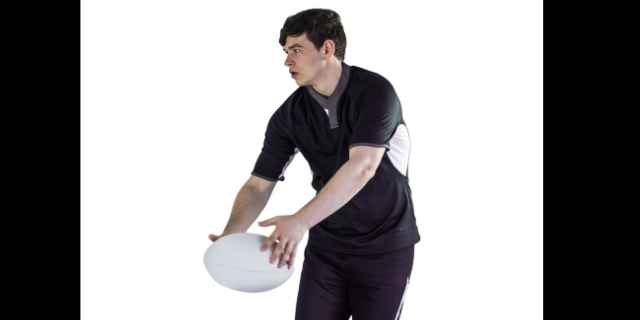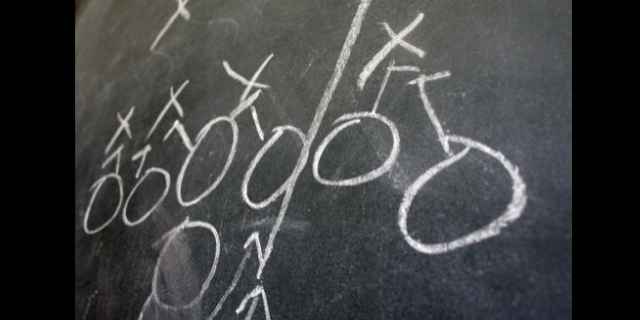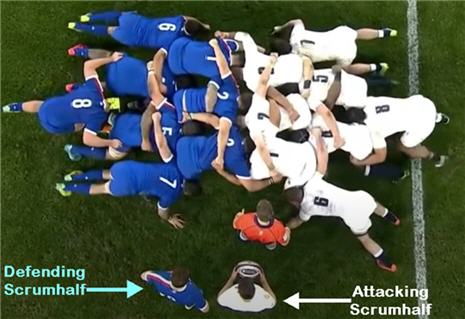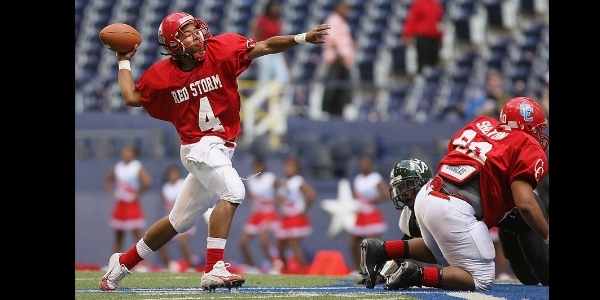Several positions in rugby take the role of quarterback at different times in a match.
Flyhalves and scrumhalves are often considered as the equivalent of quarterbacks in American football.
But locks, number eights, and outside backs can also take on quarterback roles. Read on to learn how.
Flyhalves As Quarterbacks In Rugby
Quarterbacks are of course the key offensive player in American football.
They initiate plays through a long pass, a short hand-off, or taking the less common option of running the ball themselves.
If you questioned rugby supporters across the world as to which position takes this initiating role, most would nominate the flyhalf.
The exception might be if you asked the same question in France or South Africa. They might point to the scrum-half. I’ll explain why in the section on scrum-halves.
Pass, run, or kick

But for now, let’s look at the role of flyhalves. They stand between the forward pack and the outside backs and usually receive the ball from the scrum-half.
They may throw a long pass to put the backs into space, or choose a short pass to a forward or inside center.
Flyhalves are far more likely than quarterbacks to run with the ball, looking to make a break through the opposition line.
And flyhalves have one more tool in their arsenal: they can choose to kick the ball forward for territory or for the outside backs to chase.
Calling the shots at set play

Set plays in rugby are when the sport is most like American football.
Flyhalves study the playbook prepared by their coaches. On the field, they usually decide which attacking pattern to deploy at a set piece.
But rugby is more democratic. If the forwards believe that they are getting the upper hand in the scrum, the pack leader may decide how the next phase unfolds. The flyhalf may want the ball quickly, but the forwards may choose to keep it under their feet and to push their opponents backward.
Jannie de Beer was a South African flyhalf who scored a record five drop-kicks in the 1999 World Cup match against England. He had this to say about his relationship with the pack:
“God gave me the talent, but the forwards gave me the ball.”
Jannie de Beer, 1999
Decision-making in open play
The flyhalf is the leader of the backline i.e. the centers, the wings, and the fullback take direction (and the ball) from their number 10.
It’s the flyhalf who chooses to switch play from one side of the field to the other. They may initiate the action by reversing direction and making a long pass back towards where the ball came from.
But often, they’ll bark the orders to the scrum-half who will swivel and pass to a different side of the field. In these situations, the scrum-half is usually crouched behind the ruck and won’t see the big picture.
Flyhalves take the “sergeant-major” role because they stand away from rucks and are constantly scanning the field for opportunities.
Scrumhalves As Quarterbacks In Rugby

Scrumhalves work in tandem with flyhalves to organize the attack. So, you could say that the quarterback attacking role is filled by dual positions in rugby.
Scrumhalves touch the ball far more often than their flyhalves. The flyhalf may be pointing and shouting instructions, but it’s the scrumhalf who follows the ball and keeps the play moving.
In France, scrum-halves are often the main decision-makers.
The French want their scrum-halves to be “Le Petit General” (the little general) on the field. That’s why I suggested earlier that French supporters would say that their scrumhalf is the Quarterback.
South African teams also tend to give their scrumhalves a lot of decision-making responsibility on the field.
When Do Locks In Rugby Take The Quarterback Role?

When players take to the field, there is far less involvement by rugby coaches than in American football.
In football, the coaches often call the play. The quarterback communicates the call in the huddle. However, quarterbacks have to be prepared to adjust the call in reaction to the opposition.
Locks have to make similar adjustments during the lineout.
There are two locks (second row forwards) on a rugby team. One of them is usually assigned the role to call the lineout play. They have a playbook to work from, but a good opposition jumper can disrupt the lineout and tear the playbook to shreds!
The flyhalf may want the ball thrown to the tail of the lineout, as this is the best tactic to run a wide attack through the backline. But the long throw is also the most difficult to execute. What if the opposition has intercepted the ball a few times?
The lineout caller can decide to go with a short throw to set up a maul, no matter the glares from the outside backs.
When Does The Number Eight Take The Quarterback Role?
Scrums are usually a great opportunity for a wide move through the outside backs.
With the opposition forwards tied into one position on the field, the wingers relish the thought of taking on their opposite number in a one-on-one situation.
These attacking moves off the scrum are usually called by the flyhalf.
The Number Eight is at the back of the scrum. Usually, their role is to ensure the ball gets cleanly into the hands of the scrum-half who whips it away from the pack forwards.
However, sometimes the Eight has to act like the Quarterback and adjust a pre-planned attacking move.
If the Eight believes that his scrum is under pressure and is about to be pushed backward, he may choose to pick up the ball and break forward to get the team out of trouble.
If he feels that the scrum is getting a slight legal wheel (rotating in one direction), he may override the pre-called play to take advantage of the unexpected opportunity.
With the opposition pack off balance, the eight may decide to take the attack into his own hands by picking up the ball and charging forward.
Outside Backs In Rugby May Take the Quarterback Role
As the play develops in a rugby match, the scrumhalf and outhalf are not always available to initiate the next move.
One may have been tackled and is stuck at the bottom of a ruck. The other may have initiated an attack with a cross-field kick and is now a long way away from the ball.
The team in possession of the ball doesn’t just wait for players to get back into their usual positions. That kind of delay also allows the opposition to get their defense into the best alignment.
Instead, another player will step into the role of continuing the attacking play. This is often one of the outside backs. They are expected to be able to pass the ball with a high degree of accuracy to initiate the attack.
Occasionally, you’ll see a prop or flanker forced to do the honors. This can result in balls flung with force over the heads of their teammates, much to the enjoyment of the opposition supporters!
Who Has The Quarterback’s Leadership Role In Rugby?

Quarterbacks are leaders of their football teams.
This doesn’t just mean that they call the plays. They also inspire their teammates into believing that they can win when the odds and the game are going against them.
The role is similar to being the captain of a rugby team. So, which position in rugby is most likely to assume the captaincy?
I’ve taken a look at the position of the captain of every World Cup-winning team since the competition began in 1987.
As you can see below, there isn’t a huge amount of variety. Three flankers (McCaw lifted the cup twice), two locks, two scrumhalves, and one hooker.
| David Kirk | All Blacks | Scrumhalf | 1987 |
| Nick Farr Jones | Australia | Scrumhalf | 1991 |
| Francois Pienaar | South Africa | Flanker | 1995 |
| John Eales | Australia | Lock | 1999 |
| Martin Johnson | England | Lock | 2003 |
| John Smit | South Africa | Hooker | 2007 |
| Richie McCaw | All Blacks | Flanker | 2011 |
| Richie McCaw | All Blacks | Flanker | 2015 |
| Siya Kolisi | South Africa | Flanker | 2019 |
Are you surprised that there are no outside backs? Well, these are just the winners. There are certainly international teams with centers, wingers, and fullbacks as their captain.
But many coaches like to appoint captains from positions that are closest to the referee at scrums and rucks. This makes it easier for the captain to communicate frequently with the match official.
Other Comparisons With American Football
Here’s some other questions you may have wondered about the sport of rugby.